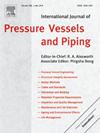Study of the mechanical response and numerical simulation of uniaxial compression of coal based on size effect
IF 3
2区 工程技术
Q2 ENGINEERING, MECHANICAL
International Journal of Pressure Vessels and Piping
Pub Date : 2025-02-13
DOI:10.1016/j.ijpvp.2025.105463
引用次数: 0
Abstract
With the intensification of coal mining, coal pillars have become weak links in mining systems, resulting in an increasing frequency of coal pillar rock burst disasters. The impact mechanisms, conditions, and failure characteristics of coal pillars vary depending on their size. For this reason, it is important to investigate the mechanical properties of coal pillars under different size conditions to prevent and control coal pillar rock bursts. In this work, the mechanical response of nine coal samples under uniaxial compression is analysed. Different coal samples undergo stress and fracture evolution during the entire failure process, which can be determined via discrete element software. The results show that (1) the stress‒strain curves of coal samples are strongly influenced by their size. When the sample diameter is 25 mm, the coal sample curve presents a three-stage failure process. As the diameter increases, the stress‒strain curve evolves gradually into a four-stage failure process. (2) The failure characteristics of the coal sample involve primarily shearing failure, which transitions from ‘single slash’ shear failure to ‘double slash’ conjugate shear failure as the diameter increases. A coal sample with a diameter-to-height ratio greater than 1:1 has primarily tensile failure characteristics. (3) Size significantly influences the energy and damage ageing evolution of coal samples during uniaxial compression. The height and diameter of a coal sample affect its dissipative energy growth starting point. The damage stage and damage rate of coal samples vary depending on their size. (4) Discrete element numerical simulations reveal that the characteristics of crack propagation are determined by the distribution of internal stress in coal samples. Macroscopic failure characteristics are determined by the types of main cracks in coal samples.
基于尺寸效应的煤单轴压缩力学响应及数值模拟研究
随着煤矿开采力度的加大,煤柱已成为采矿系统中的薄弱环节,导致煤柱冲击地压灾害的发生频率越来越高。煤柱的冲击机制、冲击条件和破坏特征随煤柱尺寸的不同而不同。因此,研究不同尺寸条件下煤柱的力学特性对防治煤柱冲击地压具有重要意义。本文对9种煤样在单轴压缩下的力学响应进行了分析。不同煤样在整个破坏过程中都经历了应力和破裂演化过程,可以通过离散元软件来确定。结果表明:(1)煤样的应力应变曲线受煤样尺寸的影响较大。当试样直径为25 mm时,煤样曲线呈现三阶段破坏过程。随着直径的增大,应力-应变曲线逐渐演变为一个四阶段破坏过程。(2)煤样破坏特征以剪切破坏为主,随直径增大由“单斜线”剪切破坏向“双斜线”共轭剪切破坏过渡;当径高比大于1:1时,煤样具有主要的拉伸破坏特征。(3)尺寸对单轴压缩煤样的能量和损伤老化演化有显著影响。煤样的高度和直径影响其耗散能增长起点。不同尺寸煤样的破坏阶段和破坏速率不同。(4)离散元数值模拟表明,裂纹扩展特征是由煤样内应力分布决定的。煤样中主裂纹的类型决定了煤样的宏观破坏特征。
本文章由计算机程序翻译,如有差异,请以英文原文为准。
求助全文
约1分钟内获得全文
求助全文
来源期刊
CiteScore
5.30
自引率
13.30%
发文量
208
审稿时长
17 months
期刊介绍:
Pressure vessel engineering technology is of importance in many branches of industry. This journal publishes the latest research results and related information on all its associated aspects, with particular emphasis on the structural integrity assessment, maintenance and life extension of pressurised process engineering plants.
The anticipated coverage of the International Journal of Pressure Vessels and Piping ranges from simple mass-produced pressure vessels to large custom-built vessels and tanks. Pressure vessels technology is a developing field, and contributions on the following topics will therefore be welcome:
• Pressure vessel engineering
• Structural integrity assessment
• Design methods
• Codes and standards
• Fabrication and welding
• Materials properties requirements
• Inspection and quality management
• Maintenance and life extension
• Ageing and environmental effects
• Life management
Of particular importance are papers covering aspects of significant practical application which could lead to major improvements in economy, reliability and useful life. While most accepted papers represent the results of original applied research, critical reviews of topical interest by world-leading experts will also appear from time to time.
International Journal of Pressure Vessels and Piping is indispensable reading for engineering professionals involved in the energy, petrochemicals, process plant, transport, aerospace and related industries; for manufacturers of pressure vessels and ancillary equipment; and for academics pursuing research in these areas.

 求助内容:
求助内容: 应助结果提醒方式:
应助结果提醒方式:


